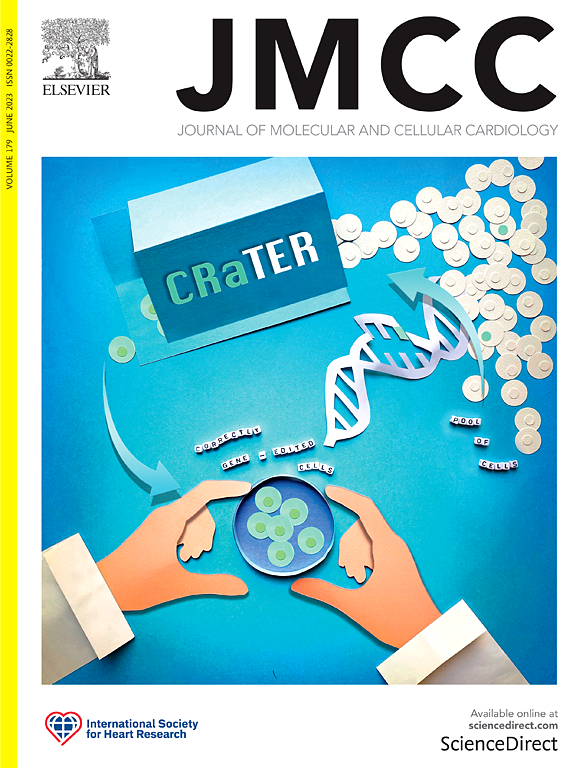Does coronary microvascular dysfunction play a role in heart failure with reduced ejection fraction?
IF 4.9
2区 医学
Q1 CARDIAC & CARDIOVASCULAR SYSTEMS
引用次数: 0
Abstract
Heart failure (HF) is a conundrum in that, current therapies only slow the progression of the disease. We posit, if the causal mechanism were targeted, progression of the disease could be stopped and potentially reversed. We hypothesize that insufficient myocardial blood flow (MBF) produces minute areas of ischemia, that lead to an accumulating injury culminating in HF. Accordingly, we determined the relationship between MBF and cardiac work (wall stress-rate product [WSRP]) in control C57Bl6/J mice (Control), mice with transaortic constriction to produce HF (TAC-HF) and HF mice treated with the coronary vasodilator, chromonar (4 weeks of treatment, TAC-Chromonar). MBF and WSRP were measured during norepinephrine infusion in anesthetized mice. In Controls, MBF increased when work/WSRP was increased with norepinephrine, however, when cardiac work was increased in TAC-HF, MBF did not increase. After chromonar treatment, when work increased, MBF increased. Changes in cardiac function paralleled MBF, i.e., decrement in cardiac function occurred in TAC-HF (ejection fraction), but 4 weeks of chromonar treatment reversed this functional decline. We also found in a model of cardiac hypoxia fate-mapping, a 5-fold increase in the number of hypoxic cardiac myocytes (TAC-HF vs Control), which was reversed by chromonar. Capillary densities also followed this trend with a decrease from Control in TAC-HF, which was restored by Chromonar. We propose that a cause of HF is inadequate MBF to meet the metabolic demands of the working heart. Pharmacological coronary vasodilation with chromonar to increase MBF in HF can reverse the functional decline and improve cardiac function.

冠状动脉微血管功能障碍是否在心力衰竭伴射血分数降低中起作用?
心力衰竭(HF)是一个难题,目前的治疗方法只能减缓疾病的进展。我们假设,如果因果机制是有针对性的,疾病的进展可以停止,并有可能逆转。我们假设心肌血流量不足(MBF)产生小区域缺血,导致累积性损伤最终导致心衰。据此,我们测定了对照C57Bl6/J小鼠(control)、经主动脉收缩产生HF的小鼠(TAC-HF)和经冠状动脉血管扩张剂chromonar治疗的HF小鼠(治疗4 周,TAC-Chromonar) MBF与心脏功(壁应力率产物[WSRP])之间的关系。在去甲肾上腺素输注麻醉小鼠时,测定其MBF和WSRP。在对照组中,当去甲肾上腺素增加工作/WSRP时,MBF增加,然而,当TAC-HF增加心脏工作时,MBF没有增加。慢性治疗后,随着工作量的增加,MBF增加。心功能变化与MBF平行,即TAC-HF(射血分数)发生心功能下降,但4 周的慢性药物治疗逆转了这种功能下降。我们还在心脏缺氧命运图模型中发现,缺氧心肌细胞的数量增加了5倍(TAC-HF vs对照组),这被chromonar逆转。在TAC-HF中,毛细管密度也遵循这一趋势,与对照相比下降,Chromonar恢复了这一趋势。我们认为HF的一个原因是MBF不足以满足工作心脏的代谢需求。药物冠脉血管舒张加色蒙纳提高心衰MBF,可逆转功能下降,改善心功能。
本文章由计算机程序翻译,如有差异,请以英文原文为准。
求助全文
约1分钟内获得全文
求助全文
来源期刊
CiteScore
10.70
自引率
0.00%
发文量
171
审稿时长
42 days
期刊介绍:
The Journal of Molecular and Cellular Cardiology publishes work advancing knowledge of the mechanisms responsible for both normal and diseased cardiovascular function. To this end papers are published in all relevant areas. These include (but are not limited to): structural biology; genetics; proteomics; morphology; stem cells; molecular biology; metabolism; biophysics; bioengineering; computational modeling and systems analysis; electrophysiology; pharmacology and physiology. Papers are encouraged with both basic and translational approaches. The journal is directed not only to basic scientists but also to clinical cardiologists who wish to follow the rapidly advancing frontiers of basic knowledge of the heart and circulation.

 求助内容:
求助内容: 应助结果提醒方式:
应助结果提醒方式:


